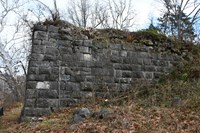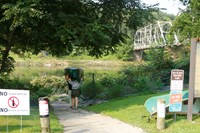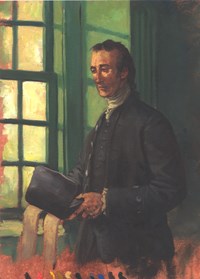- Boston African American National Historic Site (62)
- Boston National Historical Park (62)
- Golden Gate National Recreation Area (45)
- Lowell National Historical Park (35)
- César E. Chávez National Monument (34)
- Homestead National Historical Park (30)
- Manhattan Project National Historical Park (29)
- Lewis & Clark National Historic Trail (27)
- Santa Fe National Historic Trail (27)
- Show More ...
- National Register of Historic Places Program (41)
- Geologic Resources Division (24)
- National Heritage Areas Program (24)
- National Historic Landmarks Program (17)
- National Center for Preservation Technology and Training (16)
- Archeology Program (15)
- Inventory and Monitoring Division (9)
- Wildland Fire Program (9)
- Network to Freedom (8)
- Show More ...
Showing 1,903 results for organized labor ...
School District Number 1
- Type: Place

Nicodemus residents saw education as foundational to their community and organized School District No. 1 in 1879, the first in Graham County. After the previous 1887 schoolhouse burned down in 1916, the District No. 1 Schoolhouse was built in 1918 and used by the district until it closed in the early 1960s.
St. Clement’s Island Museum
- Type: Place

Discover the St Clement’s Island Museum where Maryland's founding story comes to life. Explore exhibits that highlight the rich history of the Piscataway People and early settlers. Stand on the historic island where the first English settlers landed in 1634, accessible by water taxi. Experience the beauty of the Potomac River and immerse yourself in the culture that shaped the Chesapeake Bay. Don’t miss the chance to learn and explore this unique site in St. Mary’s County.
Pollinator Garden
Thomas Stone
- Type: Person
- Type: Article

Margaret is one of Hampton’s longest serving volunteers and has seen nearly 40 years of change in the park, its visitation, and how the site’s collection of historic structures and over 45,000-object collection are used to interpret the stories of those who lived and labored at the once 25,000-acre plantation.
Oak Ridge Wayside: Scarboro
Oak Ridge Wayside: Oak Ridge Bombers
Historic Turnpike Crossing
- Type: Place

The Valley Turnpike was the main transportation route through the Shenandoah Valley in the early 1800s. During the Civil War both US and Confederate armies used it. The armies contested the crossing at Cedar Creek during the campaigns of 1862 and 1864, with the bridge burned and rebuilt several times.
Greyhound Bus Burning Site
- Type: Place

Greenwich Village Historic District’s reputation for dynamism can be attributed to its history of emerging artists and writers as well as the political unrest and activism of its inhabitants. With the rise of the counterculture movement during the 1960s, Greenwich Village’s Washington Square Park became a hub for writers and musicians. In 1969, LGB residents of Greenwich Village pushed back against police harassment at the Stonewall Inn.
Skinners Falls River Access
- Type: Place

The Skinners Falls River Access is a public river access for the Delaware River located near Milanville, PA adjacent to the Skinners Falls Bridge. It is owned by the New York Department of Environmental Conservation. This is a canoe/kayak access only. Please note the Skinners Falls Bridge is closed to all traffic at this time.
Appalachian Clubhouse
Marching for Justice in the Fields
- Type: Article

The farm workers who marched from Delano to Sacramento represented the large, seasonal labor force, composed overwhelmingly of people of color, whose labor made California’s thriving agricultural industry possible. Although their labor produced fortunes from the soil, they were subjected to poor wages and working conditions. This article is an introduction to the issues that motivated the Delano Grape Strike and the 1966 march.
Thirty Years of Farmworker Struggle
- Type: Article

Labor organizing has a long history in agriculture. Between 1930 and 1960, diverse groups of farmworkers in California struggled to form unions and to take collective action for better wages and working conditions. This article highlights the political and legal structures that made organizing in the fields especially difficult.
The Terrain of Farmworker Life
- Type: Article

Large-scale commercial agriculture or agribusiness has shaped the landscape of California's Central Valley for over a century. This article explores the social and economic world created by agribusiness in and around the small city of Delano, with an emphasis on the lives of the predominately Filipino, Mexican, and Mexican American farm workers and their families.
A New Era of Farmworker Organizing
- Type: Article

This article explores changes in farm work and farmworker organizing that took place in the 1960s. The end of the Bracero Program, a strike wave, and the emergence of the Black Freedom Movement, all played a role in expanding the opportunities for farmworker organizing. So too did the emergence of a new organization, the National Farm Workers Association.
A Continuing Struggle
- Type: Person

Mrs. Recy Taylor was just 24 years old when she was brutally raped by six white men in Alabama. Upholding the Black woman's tradition of testimony and protest, Taylor actively participated in the pursuit to bring her attackers to justice. Though the men were acquitted in two separate trials, Taylor's courage speaks to the resolve of Black women to channel their pain and anger into political anger. We honor Taylor as an ancestor for teaching us a lesson on courage.









